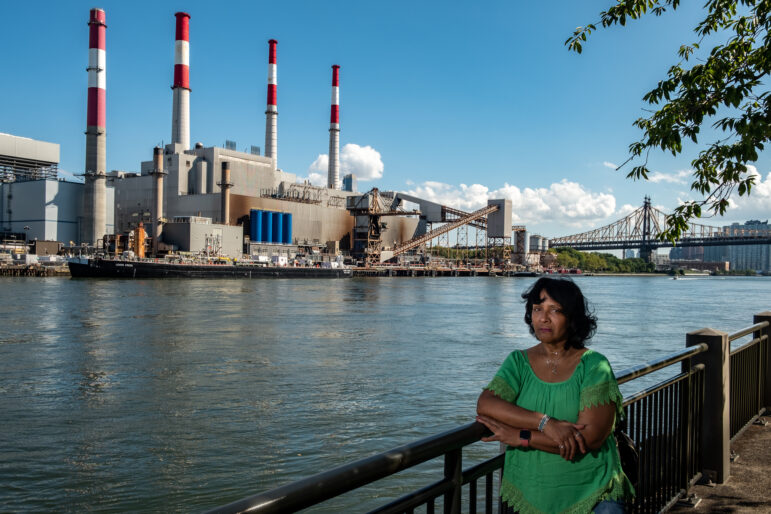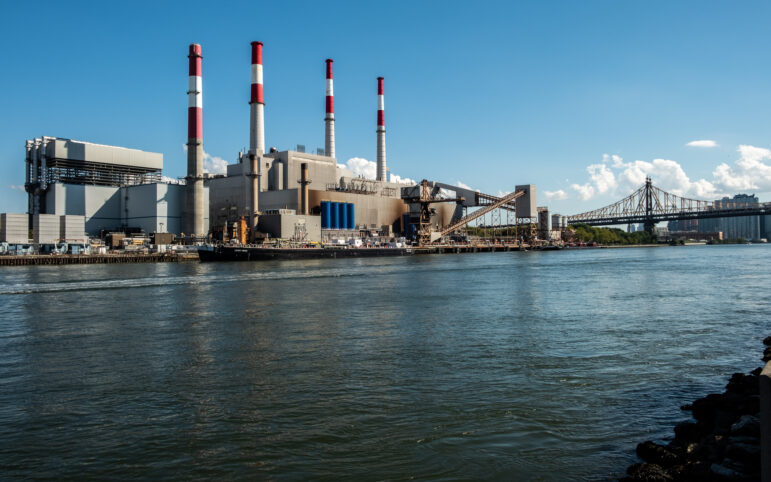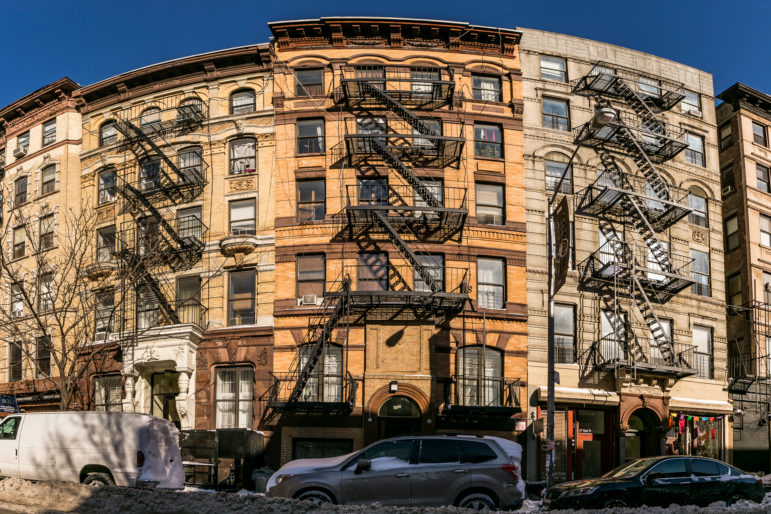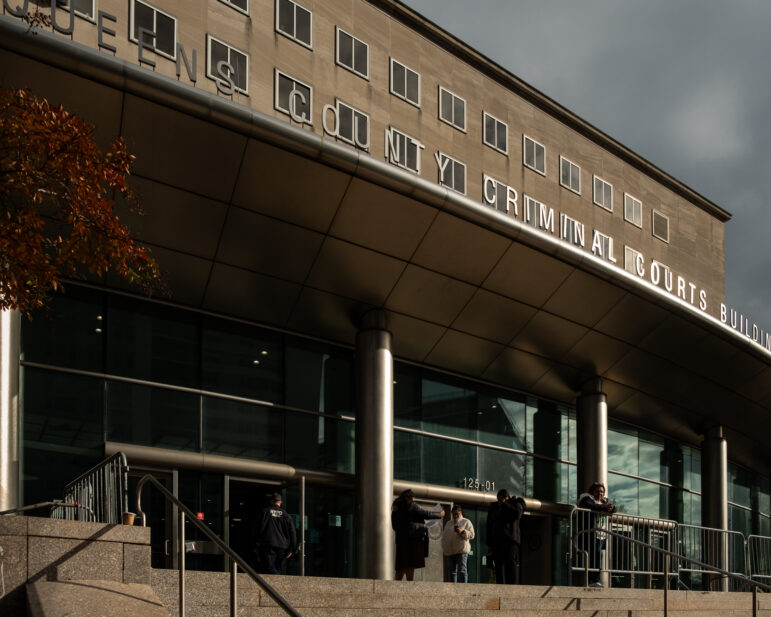A plan to transform the Ravenswood Generating Station into a clean energy center is in the works, with a vote on an offshore wind proposal expected this fall. Queens community members near the plant say that the stakes could not be higher.

Adi Talwar
Jean Tomasulo on the shoreline of Roosevelt Island with the Ravenswood Generating Station in the background. Tomasulo, 61, has lived in Ravenswood Houses for 30 years; her son was diagnosed with asthma at the age of 3.Claudia Coger remembers waking up to the smell of Silvercup bread when she moved to NYCHA’s Astoria Houses in Queens 68 years ago. The delightful scent emanating from the nearby bakery was her daily alarm clock.
But the smell of bread wasn’t the only thing circulating through the air; the nearby Ravenswood Generating Station, the largest power plant in the city, was pumping out plumes of smoke through its red and white stacks. For years, Coger watched the scene from her window in awe, initially unaware of the effect the pollution was having on her community’s lungs.
“It was just beautiful,” she said. “Nobody thought it was something that’s going to cause illnesses later on in life.” Now, Coger looks back on that smoke as the “silent enemy” that has fueled the asthma crisis in her neighborhood, earning it the nickname “asthma alley.”
“I’ve been blessed not to suffer from asthma, but I know the record,” said Coger. “And I know if they don’t do something about it, it’s not going to get better, it’s going to get worse.”
Coger and her community might finally be getting some relief. A multibillion dollar plan to transform Ravenswood Generating Station into a clean energy center is in the works, with a vote on an offshore wind proposal for the plant expected this fall. Community members say that the stakes could not be higher.
“If they don’t choose this project, what’s going to continue to happen is that residents from public housing are going to continue to have fumes and pollution pumped into their windows from across the street,” said Costa Constantinides, former city councilmember for district 22, which includes Astoria, and now CEO of the nearby Variety Boys and Girls Club of Queens.
Unlocking ‘Renewable Ravenswood’
The idea for a “Renewable Ravenswood” was introduced by the current owner of the power plant, Rise Light and Power. The overarching plan promises to replace the fossil fuels the plant currently runs on with renewable energy sources. Rise Light and Power hopes to start the transition by the end of this decade into the early 2030s, noting that the state’s permitting process can take years.
As part of the plan, Ravenswood would retire and replace three steam generators dating back to 1960 with offshore wind and solar power, while maintaining a newer unit from 2004 that’s powered by a combination of gas and steam. The infamous stacks would also be razed as part of the transition.
“The state has a very ambitious goal to be 100 percent renewables by 2040,” said Clint Plummer, chief executive officer at Rise Light and Power, in an interview this month, referring to New York’s landmark law, the Climate Leadership and Community Protection Act, passed in 2019. “So we obviously will comply with that goal.”
Plummer added that Rise Light and Power has already retired some of the fossil fuel machinery at Ravenswood, including 17 polluting “peaker” units—which kick in when the power grid hits high capacity—from the 1960s and 1970s, and that new renewable energy sources are expected to deliver even more electricity than the 20 percent of the city total that the plant currently supplies.
One of the first phases of “Renewable Ravenswood” will be introducing offshore wind infrastructure to the plant. In January, a developer named Attentive Energy One submitted a bid to the New York State Energy Research and Development Authority (NYSERDA) as part of the authority’s third offshore wind solicitation, which invites developers to submit proposals on how to deliver wind power to New York State.
Six plans are under consideration this year. Some of the bids also list sites on Staten Island as potential manufacturing and assembly hubs for offshore wind turbines. The authority’s website says they expect to announce awards this fall or winter. NYSERDA has hosted two offshore wind solicitations in the past, in 2018 and 2020. For both of those rounds the agency selected two proposals.
If approved, Attentive Energy’s plan would transport energy generated from a yet-to-be-built offshore wind farm south of Long Island and other sources upstate to Ravenswood Generating Station via underground cables. This could help power over 700,000 homes, according to Damian Bednarz, managing director at Attentive Energy.
“Attentive Energy One essentially unlocks ‘Renewable Ravenswood,’” he told City Limits.
Both Rise Light and Power and Attentive Energy said they are committed to keeping the city’s lights on during the transition to clean energy.
“We’ve designed our connection for the offshore wind and other renewables projects in such a way that the existing generators continue to operate until such time as the grid operator…determines that they can be retired for reliability purposes,” said Plummer.

Adi Talwar
The Ravenswood Generating Plant, known to some as “Big Allis,” opened in 1963. It is bordered by three NYCHA developments: Astoria Houses, Ravenswood Houses, and Queensbridge Houses.‘Deliberate environmental racism’
The Ravenswood Generating Plant, known to some as “Big Allis,” opened in 1963. It is bordered by three NYCHA developments: Astoria Houses, Ravenswood Houses, and Queensbridge Houses, the largest NYCHA complex in the city. Advocates say that the plant’s close proximity to the affordable housing developments is not a coincidence.
“The largest public housing development in the country is sitting across from Ravenswood and it was no accident that it was placed there,” said Constantinides, who has lived in the neighborhood his entire life. “There was deliberate environmental racism here.”
The most recent New York City Community Air Survey (NYCCAS) shows slightly elevated levels of nitrogen oxides (NOx) and particulate matter in the Long Island City area, just south of the Ravenswood Generating Plant.
The former is linked to increased emergency department visits and hospitalizations for asthma while the latter can exacerbate the condition, according to Holger Eisl, environmental scientist at the Barry Commoner Center at Queens College and one of the leads on the air survey project. The survey does also show, however, that air quality in the area has improved over the years.
According to 2018 data from the New York City Department of Health and Mental Hygiene, asthma hospitalization rates among children and adults in Long Island City and Astoria were lower than the citywide average.
Jean Tomasulo, 61, has lived in Ravenswood Houses for 30 years. Her son was diagnosed with asthma at the age of three. She often had to take him to the hospital because his symptoms got so bad.
The health issues go far beyond her son—Tomasulo said it’s rare to meet someone in the community whose life hasn’t been affected by asthma, chronic obstructive pulmonary disease (COPD), or cancer in some way. Studies show a link between poor air pollution and these conditions.
Now that she’s aware how much havoc the pollution has wreaked on her neighbors’ health, Tomasulo has become an advocate for change. The Ravenswood resident said she has gathered over 100 signatures on a petition calling on Gov. Kathy Hochul to clean up Ravenswood.
“I show them the picture [of the stacks],” she said. “I’m like, they’re polluting our air. Will you sign this petition?”
The community effort to clean up Ravenswood has gained more traction in recent years. On July 17, the newly-formed advocacy group Take Down the Stacks organized a rally to showcase their support for “Renewable Ravenswood.” Over 200 NYCHA residents and advocates attended, according to a press release from the group.
A denial of Attentive Energy’s bid would not result in energy production interruptions, according to Rise Light and Power, but the renewable transition would be delayed. In the meantime, the plant would continue to rely on fossil fuels to produce electricity.
As NYSERDA’s offshore wind award announcement grows closer, residents say they are eager to see the transition to renewable energy as soon as possible. They don’t want the pollution to cause any more harm than it already has.
If the plant continues to operate as is, it’s going to “affect lives and even take lives,” said Tomasulo.







